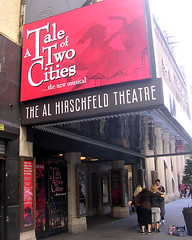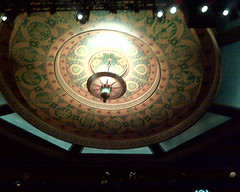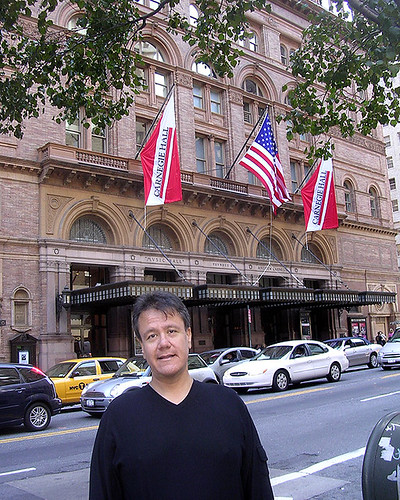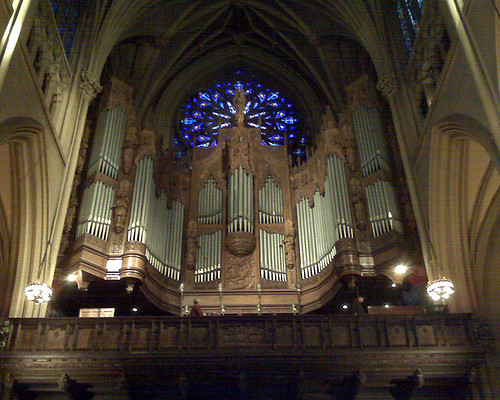
The French have their
Les Misèrables musical, now the English-speaking world has its
A Tale of Two Cities. There's a big difference between Victor Hugo's enormously long novel of the French Revolution and Charles Dickens' long novel of the French Revolution, but the thing they both have in common is that they are both thick books with involved, convoluted plots; I don't see how either of them can be condensed into a Broadway musical.
I'm not sufficiently an expert on Broadway to predict what will and will not last. Personally, I've never seen the attraction either to
Les Misèrables or to
Cats, yet both of those dreadful musicals have had enormous financial success and longevity. What will happen to
Tale? I don't know. Thus far, the New York reviews have been lukewarm to negative; yet what I saw last night in the house was an audience that seemed to particularly enjoy and appreciate the performance. And, strangely, I enjoyed it, too, it's rather uninspired and formulaic music notwithstanding, but I've always liked Dickens and I've still never been able to force myself to read a Hugo novel cover to cover.
 A Tale of Two Cities
A Tale of Two Cities formally held its opening night Thursday. Not having a tuxedo with me, I deferred my attendance to last night, thinking things would still be fresh and the cast would be in better voice, not having opening night jitters with which to contend. Playing at the Al Hirschfeld Theater, the musical is directed and choreographed by Warren Carlyle and music is directed and conducted by Kevin Stites, using the new book, music, and lyrics by Jill Santoriello.
Many aspects of the production were very impressive. I loved the costume design (by David Zinn). So many times, I've sung operas where the characters were common peasants all dressed in dark, drab colors, but Zinn was able to find opportunity for color in their lives. "Prison clothes" even looked like they had at one time been colorful finery that now was faded, tattered, and filthy. And the happy wardrobes of the protagonists were particularly fine and beautiful. Tony Walton's scenic design fascinated me, as he used a series of three three-story iron structures, all on wheels, that were wheeled around the stage by cast members to change scenic locations, with props and the occasional flown signage helping to fill out the visual pictures. Richard Pilbrow's lighting design is particularly impressive. In addition to lighting the mass cast scenes, he also had to do pin lighting to show various tiny vignettes to draw attention from other areas of the stage during scene changes and he and the director concocted very creative ways of depicting guillotine scenes in a way that executes the aristocrat whilst leaving the actor alive for another show.
I would be remiss if I did not recognize the work of the casting agents, Barry Moss and Bob Kale. What really, really made this show was the second tier of performers, all strong character actors, and Moss and Kale did such an excellent job in casting it was as though they had plucked the very people off the streets of Dickensian London.
Now, it's unusual for a play review to mention these technical people first, before discussing the merits of the musical and the actors playing the roles, but in the case of
A Tale of Two Cities, it's these technical aspects that make the show, and, hence, my rationale for their preliminary discussion.
I intentionally chose not to read any reviews until after I had seen the show. Then as I made my way home for the night, I started thinking about what to say. This morning, I read the reviews by
The New York Times and
The Wall Street Journal, plus a couple of others, and it's going to be very difficult to say much about the music and the singers without plagiarizing (and even saying that is close to plagiarizing!). They all make their comparisons to
Les Misèrables. I also was reminded of recent semi-successful musicals
Jeckyll and Hyde and
Titanic, and those were mentioned, too. The
WSJ reviewer even mentioned an opera I'd sung before called (in English)
Dialogues of the Carmelites, a story of Carmelite nuns in the French revolution by Francis Poulenc, and much like him, I thought of the Poulenc during the final guillotine scene. I suppose this all goes to support my long-time assertions that there is very little that is original on Broadway these days, with practically everything falling in to the molds of the formulaic musicals of Andrew Lloyd-Webber,
Les Misèrables,
Chicago,
Rent, or the Disney productions.
Jill Santoriello is either a genius or a hack. I'm not sure yet which. She packed in a huge amount of plot into the musical, so much so that it was almost but not quite overwhelming. She did a great job fleshing out the secondary characters, and she really developed the leading man, Carton, but the other leads Lucie, Charles, and Dr. Monette were poorly developed. But, she got through the book, she developed the elaborate plot, she told the story, and she told
Dickens's story, not a story of her own reimagining.

James Barbour, playing the English barrister Sydney Carton and the main character of the story, completely wowwed me. As I told him at the stage door after the performance, it's not often that I (as a baritone performer myself) like the work of other basses and baritones, but he really impressed me. I predict at least a Tony nomination for him for this role. He was witty and sarcastic, and one could see his character's development over the course of the musical. While in some of the scenes, he sang in the Broadway-stereotypical falsetto for soft, high passages, when the music demanded it, he had a full, powerful bass voice with a good top that I could hear (remembering that I was on the front row just to the left of the conductor) over the amplification system.
The other strong voice in the ensemble is Brandi Burkhardt as Lucie Manette. She has a nice, pure, spinto soprano and she was able to sing operatically and properly most of the show. She is also a very beautiful woman! I blew her a kiss during the curtain call and she not only smiled back at me, she remembered me afterwards at the stage door.
The other soprano did very well, although in a very small part, with Mackenzie Mauzy singing the Seamstress. She reminded me of Kristin Chenoweth, both physically and vocally. The mezzo is Natalie Toro, who sings the angry role of Madame Defarge. She did well but really only had one song with which to show off her talents; in other spots, though, I did not find the score kind to her.
The other two leading men were both tenors, with Aaron Lazar as the fated lover Charles Darnay, and Gregg Edelman as Dr. Alexandre Manette. Edelman did what he could with the role, trying to show that after seventeen years of unjust imprisonment in the Bastille, he'd suffered psychological damage, but I was just left feeling that Manette's role was tentative. Lazar, on the other hand, enjoyed the camp of his role and sang well, though he's sung Broadway too long—he is both too dependent upon the microphones and he's allowed his top to be a bit strangled and tight. He and Burkhardt, though, made an excellent couple and had a great chemistry between them.
And thus was my observation of the new
A Tale of Two Cities. What will happen to it, I don't know. If the show lasts until the Tony Awards, it could well be around for a long time. I certainly found it entertaining, though with tickets at $110, I'm not sure how many times I would be willing to see it again (or any Broadway show, since this is pretty much the going rate these days). I actually would like to see the show at least one more time, because I want to see if any of the tunes are going to become popular tunes—a couple of Carton's ditties I'd like to sing myself. Santoriello didn't write any of the songs with repeating themes or with reprises, so the hit songs are going to take a little longer to emerge.


 The French have their Les Misèrables musical, now the English-speaking world has its A Tale of Two Cities. There's a big difference between Victor Hugo's enormously long novel of the French Revolution and Charles Dickens' long novel of the French Revolution, but the thing they both have in common is that they are both thick books with involved, convoluted plots; I don't see how either of them can be condensed into a Broadway musical.
The French have their Les Misèrables musical, now the English-speaking world has its A Tale of Two Cities. There's a big difference between Victor Hugo's enormously long novel of the French Revolution and Charles Dickens' long novel of the French Revolution, but the thing they both have in common is that they are both thick books with involved, convoluted plots; I don't see how either of them can be condensed into a Broadway musical. A Tale of Two Cities formally held its opening night Thursday. Not having a tuxedo with me, I deferred my attendance to last night, thinking things would still be fresh and the cast would be in better voice, not having opening night jitters with which to contend. Playing at the Al Hirschfeld Theater, the musical is directed and choreographed by Warren Carlyle and music is directed and conducted by Kevin Stites, using the new book, music, and lyrics by Jill Santoriello.
A Tale of Two Cities formally held its opening night Thursday. Not having a tuxedo with me, I deferred my attendance to last night, thinking things would still be fresh and the cast would be in better voice, not having opening night jitters with which to contend. Playing at the Al Hirschfeld Theater, the musical is directed and choreographed by Warren Carlyle and music is directed and conducted by Kevin Stites, using the new book, music, and lyrics by Jill Santoriello. James Barbour, playing the English barrister Sydney Carton and the main character of the story, completely wowwed me. As I told him at the stage door after the performance, it's not often that I (as a baritone performer myself) like the work of other basses and baritones, but he really impressed me. I predict at least a Tony nomination for him for this role. He was witty and sarcastic, and one could see his character's development over the course of the musical. While in some of the scenes, he sang in the Broadway-stereotypical falsetto for soft, high passages, when the music demanded it, he had a full, powerful bass voice with a good top that I could hear (remembering that I was on the front row just to the left of the conductor) over the amplification system.
James Barbour, playing the English barrister Sydney Carton and the main character of the story, completely wowwed me. As I told him at the stage door after the performance, it's not often that I (as a baritone performer myself) like the work of other basses and baritones, but he really impressed me. I predict at least a Tony nomination for him for this role. He was witty and sarcastic, and one could see his character's development over the course of the musical. While in some of the scenes, he sang in the Broadway-stereotypical falsetto for soft, high passages, when the music demanded it, he had a full, powerful bass voice with a good top that I could hear (remembering that I was on the front row just to the left of the conductor) over the amplification system.